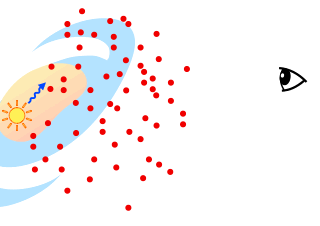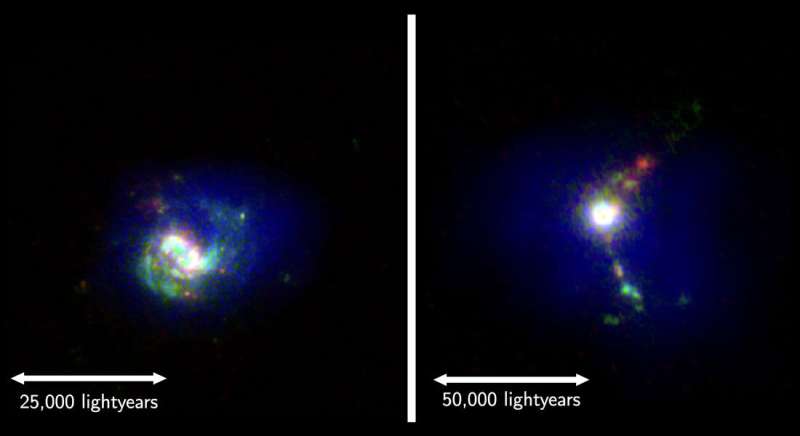To better understand observations of the most distant galaxies, an international team of astronomers has built a sample of local galaxies which can be studied in much higher detail. In a newly published study they show how the amount of light that escapes from a galaxy is connected to its physical properties. The result has implication for how we interpret observations of galaxies in the early universe.
One of the most informative ways to study galaxies in the early universe is through a particular type of ultraviolet light called “Lyman alpha.” This light is emitted from gas around the hottest stars, and is therefore particularly good for observing galaxies that are highly star-forming.
Unlike other types of light, however, the exact wavelength and direction of traveling depends on many physical processes inside and outside the galaxies. Lyman alpha light doesn’t just travel directly towards our telescopes, but takes on a complicated path out of the galaxy.
On its way, it travels through regions of different physical conditions which affect not only the path individual light particles take, but also changes their wavelength and even absorb an unspecified fraction of the light.
Some regions are hotter, some are more dusty, some have strong flows of gas clouds, etc. All these physical conditions makes it notoriously difficult to interpret the Lyman alpha light that we see. On the other hand the reward, if interpreted correctly, is substantial, exactly because we can then learn about the physics of the galaxy.

Lyman alpha photons are emitted from gas around stars, but on their way out of the galaxy they hit thousands or even millions of hydrogen atoms. At each interaction, they change direction and wavelength randomly. © Peter Laursen/Cosmic Dawn Center.
Spying on our neighbors
Galaxies in the distant universe are faint and small, and hence particularly difficult to observe. An international team of astronomers therefore set out to built a “reference” sample of galaxies in our local neighborhood. While still hundreds of millions of lightyears away, they are near enough that they can be studied in great detail, with many different telescopes around the world and in space.
This so-called Lyman Alpha Reference Sample, or LARS, has revealed many interesting properties of galaxies that are extremely helpful when observing the more distant ones. In the latest study, led by Jens Melinder, Senior Researcher at the University of Stockholm, and published in The Astrophysical Journal Supplement Series, the astronomers deduced how much of the Lyman alpha light escapes the galaxy, and whether or not this fraction correlated with various physical properties of the galaxy.
“With the new observations, we have established a connection between how much Lyman alpha escapes the galaxies, and several of the physical properties of these galaxies,” explains Melinder. “For instance, there is a clear correlation between the amount of cosmic dust a galaxy has, and how much Lyman it lets out. This was expected, because dust absorbs light, but now we have quantified the effect.”
The astronomers also found a connection between the escaping light and the total mass of all the stars in the galaxy, although less explicit. On the other hand other properties, such as the amount of new stars that the galaxy forms, did not seem to correlate with the amount of Lyman alpha that escapes the galaxy.

Two galaxies from the LARS sample, here observed through filters that enhance specific physical processes: Green colors show light from the stars. Red shows where the Lyman alpha photons are emitted, and blue shows where they are observed, i.e. where they escape the galaxies (colors “add”, so e.g. white means that all three colors are present). It is clear that the Lyman alpha photons do not travel directly toward our telescopes, but are “trapped” inside the galaxies until they are eventually able to escape quite far away, creating a “halo” of Lyman alpha light in the outskirts of the galaxies. © Melinder et al. (2023)
Another interesting result is that galaxies observed in Lyman alpha appear considerably larger than when observed at other wavelengths. This effect has been seen before, and is in line with the theoretical expectations.
“We see the same effect in computer simulations of galaxies with calculations of how Lyman alpha travels through the gaseous clouds in interstellar space,” explains Peter Laursen from the Cosmic Dawn Center who also participated in the study. “This confirms that we have a rather good theoretical understanding of the physics at play.”
This effect is important to take into account when observing distant galaxies where light from the outskirts of the galaxies is too faint to be detected, or falls outside of the detectors.
The quantification of the effect will be helpful in future observations of the most distant and hence earliest galaxies:
“These results will help in interpreting observations of very distant, but similar, galaxies observed with the Hubble and James Webb Space Telescopes,” says Melinder. “Understanding the detailed astrophysics of this type of galaxies is crucial for developing theories of how the first galaxies formed and evolved.”
More information:
Jens Melinder et al, The Lyα Reference Sample. XIV. Lyα Imaging of 45 Low-redshift Star-forming Galaxies and Inferences on Global Emission, The Astrophysical Journal Supplement Series (2023). DOI: 10.3847/1538-4365/acc2b8
Provided by
Niels Bohr Institute
Citation:
Spying on our neighbors: Local galaxies help astronomers understand distant galaxies (2023, May 10)



